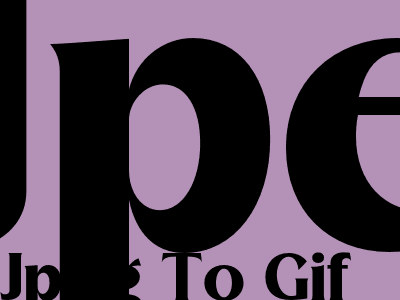Convert Images from JPEG to GIF: A Comprehensive Guide
Introduction:
In the digital realm, images are ubiquitous. Two popular image formats, JPEG and GIF, serve distinct purposes and offer unique advantages. JPEG (Joint Photographic Experts Group) is a lossy compression format designed for realistic images, while GIF (Graphics Interchange Format) is a lossless format suitable for simple animations and graphics.
In this comprehensive guide, we will delve into the process of converting JPEG images to GIF, exploring different methods, optimizing the conversion for various purposes, and providing troubleshooting tips to ensure a seamless experience. Whether you're a beginner or an experienced user, this guide will empower you with the knowledge and skills to convert JPEG to GIF effectively.
Methods for Converting JPEG to GIF:
There are multiple approaches to converting JPEG to GIF, each with its advantages and limitations:
Online Conversion Tools:
Numerous online converters offer quick and easy JPEG to GIF conversion. These tools are convenient and require no software installation. However, some converters may impose limitations on file size or offer limited editing options.
Desktop Software:
Dedicated image editing software, such as Adobe Photoshop or GIMP, provides more control over the conversion process. These programs offer advanced editing features, batch processing capabilities, and higher-quality conversions compared to online tools.
Command-Line Tools:
For more advanced users, command-line tools like ImageMagick provide a powerful way to convert JPEG to GIF. These tools offer flexibility and automation but require technical proficiency and familiarity with command syntax.
Optimizing the Conversion:
To optimize the conversion process and achieve the desired results, consider the following factors:
Color Palette:
GIFs support a limited color palette of 256 colors. If your JPEG image contains a wide range of colors, it's essential to reduce the palette size to avoid banding or posterization in the converted GIF.
Transparency:
GIFs support transparency, allowing you to create images with transparent backgrounds. To preserve transparency in the converted GIF, ensure your JPEG image includes transparent areas.
Animation:
GIFs can be animated by combining multiple frames. If you want to create an animated GIF, you'll need a series of JPEG images that represent the different frames of the animation.
Troubleshooting Common Issues:
During the conversion process, you may encounter certain issues. Here are some common problems and their solutions:
Grainy or Pixelated GIFs:
Ensure that you use a high-quality JPEG image as the source. Additionally, adjust the compression settings in the conversion tool to minimize image degradation.
Incorrect Color Reproduction:
Verify that the color profile of your JPEG image is set correctly. Different color profiles can result in color shifts during conversion. Consider using a color management system to ensure accurate color reproduction.
GIF Animation Not Working:
Make sure that you have created a series of JPEG images in the correct order for the animation. Additionally, check the conversion settings to ensure that the animation parameters are set appropriately.
Conclusion:
Converting JPEG to GIF is a versatile technique that empowers you to create compelling images for various online applications. By following the methods outlined in this guide, optimizing the conversion process, and addressing common issues, you can effectively transform your JPEG images into high-quality GIFs. Whether you're a graphic designer, web developer, or simply looking to enhance your digital content, this comprehensive guide will equip you with the knowledge and skills to achieve exceptional results.

Comments